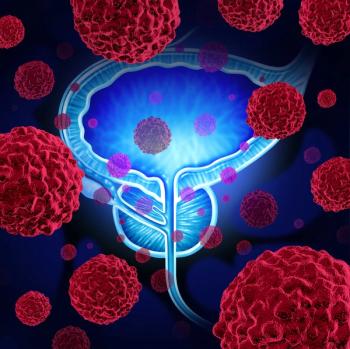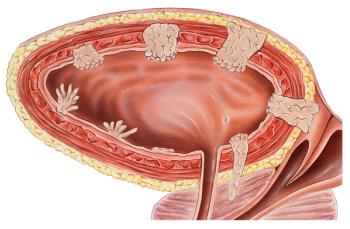
Oncology NEWS International
- Oncology NEWS International Vol 10 No 8
- Volume 10
- Issue 8
Atrasentan May Delay Advanced Prostate Cancer Progression
SAN FRANCISCO-Atrasentan (ABT-627), an investigational endothelin-A receptor antagonist made by Abbott Laboratories, appears to delay clinical progression, PSA progression, and bone progression in hormone-refractory prostate cancer patients, according to phase II clinical trials presented at the 37th Annual Meeting of the American Society of Clinical Oncology (ASCO).
SAN FRANCISCOAtrasentan (ABT-627), an investigational endothelin-A receptor antagonist made by Abbott Laboratories, appears to delay clinical progression, PSA progression, and bone progression in hormone-refractory prostate cancer patients, according to phase II clinical trials presented at the 37th Annual Meeting of the American Society of Clinical Oncology (ASCO).
Michael A. Carducci, MD, assistant professor of oncology, Johns Hopkins University School of Medicine, reported on 244 evaluable asymptomatic patients of 288 patients who had been randomized in nine countries. Two thirds of the patients were in Europe, and all had a life expectancy of less than 12 months. Their median age was 70, and 200 patients experienced disease progression.
He said that the median time to clinical progression increased from 129 days in patients given placebo to 184 days in patients given 2.5 mg of atrasentan daily and to 196 days when the dose was increased to 10 mg(P < .05) (Figure 1). The median time to PSA progression also lengthened from 71 days for the placebo arm to 155 days for patients who received 10 mg of atrasentan (P < .05) (Figure 2). Patients treated with the 10-mg dose also gave better quality-of-life reports than the placebo patients, Dr. Carducci said. Survival data are not yet available.
Figure 1 (top left) shows median time to clinical progression (study M96-594) for 244 asymptomatic men with hormone-
refractory prostate cancer who received placebo, 2.5 mg/d of the potent oral endothelin-A receptor antagonist atrasentan (ABT-627), or 10 mg/d of atrasentan. Figure 2 (top right) shows the time to PSA progression from the same study. Figure 3 (left) shows bone alkaline phosphatase levels (a serum marker of bone formation) from two randomized studies (including M96-594) of men with hormone-refractory prostate cancer who received atrasentan, 2.5 mg (n = 135) or 10 mg (n = 137), or placebo (n = 147). Men receiving atra-sentan had significantly lower levels of bone alkaline phosphatase, compared with placebo. Figures 1 and 2 are courtesy of Dr. Michael Carducci, of Johns Hopkins University. Figure 3 is courtesy of Dr. Joel Nelson, of the University of Pittsburgh Medical Center.
The most common adverse events were peripheral edema (35% vs 14% of the placebo group), rhinitis (28% vs 13%), and headache (20% vs 10%).
Joel N. Nelson, MD, co-director of the Prostate and Urological Cancer Center, University of Pittsburgh Medical Center, analyzed pooled data from 419 patients with hormone-refractory prostate cancer from Dr.Carducci’s study and from a second trial of atrasentan in symptomatic patients. He looked at several biomarkers of bone progressionserum markers of bone formation (total and bone alkaline phosphatase) (see Figure 3) and markers of bone resorption such as collagen cross-linked urine N-telopeptides and urine deoxypyridinoline.
How Atrasentan Blocks Cell Growth
Endothelins (ETs) are vasoactive peptides with growth-factor activity in a wide range of tissues. Normally, binding of ET-1 to the ET-A receptor leads to signaling through the Ras/Raf pathway to induce gene expression. Signaling by ET-1 promotes cell proliferation, stimulates bone remodeling, inhibits apoptosis, induces secretion of vascular endothelial growth factor (VEGF), stimulates angiogenesis, and mediates pain responses.
Atrasentan binds to the ET-A receptor, blocking ET-1 receptor signaling and inhibiting its downstream effects. Consequently, atrasentan inhibits cell proliferation and bone remodeling.
A variety of human tumors and tumor cell lines express ET-A receptors and secrete ET-1. In the prostate, the predominant endothelin receptor subtype expressed shifts from ET-B, the clearance receptor in normal prostate, to ET-A in prostate cancer cells.
At baseline, the serum markers and markers of bone resorption were elevated 2.2- to 3.6-fold above normal levels. Dr. Nelson reported that in patients receiving the 10-mg dose of atrasentan, biomarker levels did not increase further. The biomarkers continued to escalate in patients who received 2.5 mg of atrasentan, but not as much as in the placebo group.
The researchers then looked at bone scans following treatment in a subset of patients. "There was significantly more bone progression for the patients on placebo, compared to those on the drug," Dr. Nelson commented. "This was the first demonstration of any drug having this effect."
Viewed together, Drs. Carducci and Nelson’s reports suggest that endothelin-A receptors are a new target for chemotherapy against osteoblastic disease, said Donald Trump, MD, deputy director for clinical investigations, University of Pittsburgh Cancer Institute.
"The trial results clearly suggest that bone progression is inhibited and strongly mandate confirmatory trials, as are planned," Dr. Trump said, alluding to two phase III trials that are scheduled to open this summer.
Both investigators forecast the organization of additional trials. Dr. Carducci spoke of testing atrasentan in combination with cytotoxic therapies and in other cancers with bone progression. "It’s a completely new area for intervention in advanced prostate cancer," said Dr. Nelson, suggesting that trials with early-stage prostate cancer are also likely.
Articles in this issue
Newsletter
Stay up to date on recent advances in the multidisciplinary approach to cancer.
























































































